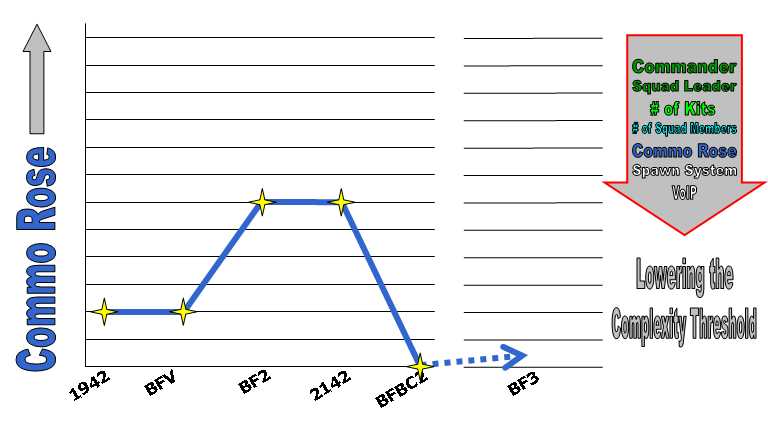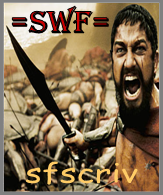Post by sfscriv on Mar 31, 2013 15:08:14 GMT 1
... Originally posted in the EA UK Forum on 27 FEB 2011

When given a choice, which one would YOU choose?
For the same price, you could get a stream-lined Ford Focus or a fully loaded Rolls Royce luxury sedan.
The vehicle on the left has a shiny high-tech paint job and a great sounding engine. The green car will last 6 months in its current condition. The vehicle on the right has a current-day quality paint job and a good sounding engine. This fine automobile will last 4 years in its current condition.
The next series of graphs illustrate Battlefield features over the years starting with Battlefield 1942 (1942) on the left and ending with, the yet to be released, Battlefield 3 (BF3). The features covered in each slide of this presentation are leadership, the number (#) of kits/classes, the number of squad members, communication (commo) rose, the spawn systems, and Voice over Internet Protocol (VoIP).
At the time of his post, which features will be bundled in the final BF3 product are, for the most part, still unknown. Some of the features analyzed have a very objective unit of measure while others are more subjective.
Discussion and disagreements are expected. “Negativity” attacks are unwanted in this thread. If you have the desire to blurt-out a short unconstructive comment, you can simply choose to not read this material and move on to the next thread.
The solid line on each graph denotes known variables and the dotted arrow line are the author’s prediction/forecast. Yes, then we can both agree that the public does not know and it is, therefore, Unconfirmed.
Alright, let’s dig into the first graph. There was an absence of integrated leaders like the commander and squad leader positions in the first two games. Both Battlefield 2 (BF2) and Battlefield 2142 (2142) had a commander and the potential of nine squadleaders for each side. (Sarcasm – Bad Company 2 (BFBC2) incorporated the innovative leadership system of “everyone is a commander.” I could not resist that poke.) In the last known installment of the Battlefield series, BFBC2, the integrated leaders were absent. The author believes we will be lucky if we get squad leader positions and, unfortunately, it looks like the the commander position has eradicated for BF3.

In this next graph, the Battlefield series started with 5-kits, dropped to four with Battlefield Vietnam (BFV), and reached a well-thought-out division of labor in BF2 with 7-kits. This was the apex of specialization in the Battlefield series with gamers cooperating to achieve success. It is believed by this author that the decline from 7-kits to 4-kits in 2142 was due to a strong desire to pad an expanded unlock system. Regrettably, the over emphasis on unlocks has hampered gameplay by reducing the weighted importance of a dedicated kit to perform a specific function. The kit count for BF3 has been confirmed at four.

The 1942 and BFV games did not have squads. BF2 and 2142 each had a six personnel capacity. BFBC2 dropped to a four person squad and BF3 has yet to be announced.

The first two Battlefield releases possessed an antiquated communication system:

Here is the refined BF2/2142 commo rose:

With DICE’s urge to “lower the complexity threshold,” it looks unlikely an equivalent teamwork facilitating communication system will be incorporated into BF3. Many Battlefield old-timers miss the quick ability to say in-game: “Yes,” “No,” “Thank You,” “Sorry,” etc… with the stroke of a hot key and mouse click.

Bear in mind that this next topic is the most subjective topic in this lay-down. The designated spawn points for Battlefield 1942 and BFV were friendly owned control points; the later games continue that tradition. In BF2, the squad leader was a mobile spawn point. This addition encouraged teamwork within the squad, maintained focus on an axis of attack, and placed greater importance on the squad leader position. 2142 raised the bar with a continuation of the squad leader spawn and the addition of a squad leader deployable spawn point. All squad members were spawn points in BFBC2. This new feature degraded teamwork and dramatically increased spawn deaths. It created a frantic gameplay environment. It is the opinion of the author that everyone in the squad will be a spawn point in BF3.

Communication with your team mates, in most cases, significantly improves the gaming experience. BF2 was the first Battlefield game in the series to integrate VoIP into the game and 2142 carried the torch of a two channel system. The commander and squad leaders could talk on the command channel and squad members could talk on the squad-internal channel. BFBC2 reduced the VoIP functionality to just internal squad members being able to talk. Squads were unable to verbally coordinate with other squads. For many months, the VoIP did not function for PC users. It is unclear if all the issues with BFBC2 VoIP have been resolved. Even if the VoIP were fully functional, the BFBC2 frenzied gameplay degrades the ability to talk to your mates.

In this last graph, the trend lines from each graph are consolidated. There is much that is still unknown about BF3 features. An increase to the spectacular graphics, audio, and destruction found in BFBC2 is likely in this next much-anticipated installment of Battlefield. The abrupt decline in previously discussed features in the BFBC2 game has disappointed lots of Battlefield fans. Will “integrated teamwork” be present in BF3 or will Battlefield Veterans be shell-shocked by the lack of features?

So, again the question will be offered. As an educated consumer and for the same price tag, would you, if given the choice, choose the little green car or the luxury sedan?

If this effort was not convincing enough, one could throw-in: LAN, Mod, Battle Recorder, and Spectate features to keep the ball rolling.

When given a choice, which one would YOU choose?
For the same price, you could get a stream-lined Ford Focus or a fully loaded Rolls Royce luxury sedan.
The vehicle on the left has a shiny high-tech paint job and a great sounding engine. The green car will last 6 months in its current condition. The vehicle on the right has a current-day quality paint job and a good sounding engine. This fine automobile will last 4 years in its current condition.
The next series of graphs illustrate Battlefield features over the years starting with Battlefield 1942 (1942) on the left and ending with, the yet to be released, Battlefield 3 (BF3). The features covered in each slide of this presentation are leadership, the number (#) of kits/classes, the number of squad members, communication (commo) rose, the spawn systems, and Voice over Internet Protocol (VoIP).
At the time of his post, which features will be bundled in the final BF3 product are, for the most part, still unknown. Some of the features analyzed have a very objective unit of measure while others are more subjective.
Discussion and disagreements are expected. “Negativity” attacks are unwanted in this thread. If you have the desire to blurt-out a short unconstructive comment, you can simply choose to not read this material and move on to the next thread.
The solid line on each graph denotes known variables and the dotted arrow line are the author’s prediction/forecast. Yes, then we can both agree that the public does not know and it is, therefore, Unconfirmed.
Alright, let’s dig into the first graph. There was an absence of integrated leaders like the commander and squad leader positions in the first two games. Both Battlefield 2 (BF2) and Battlefield 2142 (2142) had a commander and the potential of nine squadleaders for each side. (Sarcasm – Bad Company 2 (BFBC2) incorporated the innovative leadership system of “everyone is a commander.” I could not resist that poke.) In the last known installment of the Battlefield series, BFBC2, the integrated leaders were absent. The author believes we will be lucky if we get squad leader positions and, unfortunately, it looks like the the commander position has eradicated for BF3.

In this next graph, the Battlefield series started with 5-kits, dropped to four with Battlefield Vietnam (BFV), and reached a well-thought-out division of labor in BF2 with 7-kits. This was the apex of specialization in the Battlefield series with gamers cooperating to achieve success. It is believed by this author that the decline from 7-kits to 4-kits in 2142 was due to a strong desire to pad an expanded unlock system. Regrettably, the over emphasis on unlocks has hampered gameplay by reducing the weighted importance of a dedicated kit to perform a specific function. The kit count for BF3 has been confirmed at four.

The 1942 and BFV games did not have squads. BF2 and 2142 each had a six personnel capacity. BFBC2 dropped to a four person squad and BF3 has yet to be announced.

The first two Battlefield releases possessed an antiquated communication system:

Here is the refined BF2/2142 commo rose:

With DICE’s urge to “lower the complexity threshold,” it looks unlikely an equivalent teamwork facilitating communication system will be incorporated into BF3. Many Battlefield old-timers miss the quick ability to say in-game: “Yes,” “No,” “Thank You,” “Sorry,” etc… with the stroke of a hot key and mouse click.

Bear in mind that this next topic is the most subjective topic in this lay-down. The designated spawn points for Battlefield 1942 and BFV were friendly owned control points; the later games continue that tradition. In BF2, the squad leader was a mobile spawn point. This addition encouraged teamwork within the squad, maintained focus on an axis of attack, and placed greater importance on the squad leader position. 2142 raised the bar with a continuation of the squad leader spawn and the addition of a squad leader deployable spawn point. All squad members were spawn points in BFBC2. This new feature degraded teamwork and dramatically increased spawn deaths. It created a frantic gameplay environment. It is the opinion of the author that everyone in the squad will be a spawn point in BF3.

Communication with your team mates, in most cases, significantly improves the gaming experience. BF2 was the first Battlefield game in the series to integrate VoIP into the game and 2142 carried the torch of a two channel system. The commander and squad leaders could talk on the command channel and squad members could talk on the squad-internal channel. BFBC2 reduced the VoIP functionality to just internal squad members being able to talk. Squads were unable to verbally coordinate with other squads. For many months, the VoIP did not function for PC users. It is unclear if all the issues with BFBC2 VoIP have been resolved. Even if the VoIP were fully functional, the BFBC2 frenzied gameplay degrades the ability to talk to your mates.

In this last graph, the trend lines from each graph are consolidated. There is much that is still unknown about BF3 features. An increase to the spectacular graphics, audio, and destruction found in BFBC2 is likely in this next much-anticipated installment of Battlefield. The abrupt decline in previously discussed features in the BFBC2 game has disappointed lots of Battlefield fans. Will “integrated teamwork” be present in BF3 or will Battlefield Veterans be shell-shocked by the lack of features?

So, again the question will be offered. As an educated consumer and for the same price tag, would you, if given the choice, choose the little green car or the luxury sedan?

If this effort was not convincing enough, one could throw-in: LAN, Mod, Battle Recorder, and Spectate features to keep the ball rolling.




